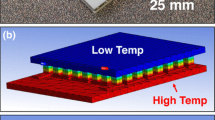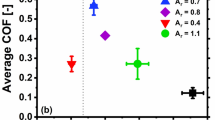Abstract
Electromechanical interaction determines the structural reliability of electronic interconnects. Using the nanoindentation technique, the effect of alternating electric current on the indentation deformation of copper strips was studied for the indentation load in a range of 100 to 1600 μN at room temperature. During the test, an alternating electric current of the electric current density in a range of 1.25 to 4.88 kA/cm2 was passed through the copper strips. The indentation results showed that the reduced contact modulus decreased linearly with increasing the electric current density. The indentation hardness decreased with increasing the indentation deformation, demonstrating the normal indentation size effect. Using the model of strain gradient plasticity, we found that the strain gradient underneath the indentation decreased slightly with increasing the electric current density for the same indentation depth.









Similar content being viewed by others
References
N.L. Michael, C.-U. Kim, P. Gillespie, R. Augur, Electromigration failure in ultra-fine copper interconnects. J. Electron. Mater. 32, 988–993 (2003)
A. Gladkikh, Y. Lereah, E. Glickman, M. Karpovski, A. Palevski, J. Schubert, Hillock formation during electromigration in Cu and Al thin films: three-dimensional grain growth. Appl. Phys. Lett. 66, 1214–1216 (1995)
A.W. Park, R.W. Vook, Activation energy for electromigration in Cu films. Appl. Phys. Lett. 59, 175–177 (1991)
T. Nitta, T. Ohmi, M. Otsuki, T. Takewaki, T. Shibata, Electrical-properties of giant-grain copper thin-films formed by a low kinetic-energy particle process. J. Electrochem. Soc. 139, 922–927 (1992)
A.S. Budiman, W.D. Nix, N. Tamura, B.C. Valek, K. Gadre, J. Maiz, R. Spolenak, J.R. Patel, Crystal plasticity in Cu damascene interconnect lines undergoing electromigration as revealed by synchrotron x-ray microdiffraction. Appl. Phys. Lett. 88, 233515 (2006)
H. Zhang, G.S. Cargill III, Electromigration-induced strain relaxation in Cu conductor lines. J. Mater. Res. 26, 498–502 (2011)
K.-C. Chen, W.-W. Wu, C.-N. Liao, L.-J. Chen, K.N. Tu, Stability of nanoscale twins in copper under electric current stressing. J. Appl. Phys. 108, 066103 (2010)
H. Ogi, A. Yamamoto, K. Kondou, K. Nakano, K. Morita, N. Nakamura, T. Ono, M. Hirao, Significant softening of copper nanowires during electromigration studied by picosecond ultrasound spectroscopy. Phys. Rev. B 82, 155436 (2010)
S. Sebastiant, S.K. Biswast, Effect of interface friction on the mechanics of indentation of a finite layer resting on a rigid substrate. J. Phys. D, Appl. Phys. 24, 1131–1140 (1991)
W.J. Poole, M.F. Ashby, N.A. Fleck, Micro-hardness of annealed and work-hardened copper polycrystals. Scr. Mater. 34, 559–564 (1996)
M.M. Chaudhri, Subsurface strain distribution around Vickers hardness indentations in annealed polycrystalline copper. Acta Mater. 46, 3047–3056 (1998)
F.Q. Yang, G.F. Zhao, Effect of electric current on nanoindentation of copper. Nanosci. Nanotechnol. Lett. 2, 322–326 (2010)
R. Chen, F.Q. Yang, Impression creep of a Sn60Pb40 alloy: the effect of electric current. J. Phys. D 41, 155406 (2008)
R. Chen, F.Q. Yang, Effect of DC current on the creep deformation of tin. J. Electron. Mater. 39, 2611–2617 (2010)
R. Chen, F.Q. Yang, Effect of electric current on the creep deformation of lead. Mater. Sci. Eng. A 528, 2319–2325 (2011)
F.Q. Yang, K. Geng, P.K. Liaw, G. Fan, H. Choo, Deformation in a Zr57Ti5Cu20Ni8Al10 bulk metallic glass during nanoindentation. Acta Mater. 55, 321–327 (2007)
V. Srinivasarao, R. Jayaganthan, V.N. Sekhar, K. Mohankumar, A.A.O. Tay, V. Kripesh, Nanoindentation study of the sputtered Cu thin films for interconnect applications, in IEEE Electron. Packaging Tech. Conf. (2004), pp. 343–347
X. Deng, N. Chawla, K.K. Chawla, M. Koopman, Deformation behavior of (Cu, Ag)-Sn intermetallics by nanoindentation. Acta Mater. 52, 4291–4303 (2004)
M. Atkinson, Origin of the size effect in indentation of metals. Int. J. Mech. Sci. 33, 843–850 (1991)
E. Manika, J. Maniks, Size effects in micro- and nanoscale indentation. Acta Mater. 54, 2049–2056 (2006)
M.F. Ashby, Work hardening of dispersion-hardened crystals. Philos. Mag. 14, 1157–1178 (1966)
N.A. Fleck, J.W. Hutchinson, A reformulation of strain gradient plasticity. J. Mech. Phys. Solids 49, 2245–2271 (2001)
P. Gudmundson, A unified treatment of strain gradient plasticity. J. Mech. Phys. Solids 52, 1379–1406 (2004)
H.B. Muhlhaus, E.C. Aifantis, A variational principle for gradient plasticity. Int. J. Solids Struct. 28, 845–857 (1991)
G.F. Zhao, M. Liu, F.Q. Yang, The effect of an electric current on the nanoindentation behavior of tin. Acta Mater. 60, 3773–3782 (2012)
D.L. Joslin, W.C. Oliver, A new method for analyzing data from continuous depth-sensing microindentation tests. J. Mater. Res. 5, 123–126 (1990)
T.Y. Zhang, W.H. Xu, Surface effects on nanoindentation. J. Mater. Res. 17, 1715–1720 (2002)
T.Y. Zhang, W.H. Xu, M.H. Zhao, The role of plastic deformation at a rough surface in the size-dependent hardness. Acta Mater. 52, 57–68 (2004)
Acknowledgement
This work is supported by NSF through Grant No. CMMI 0800018.
Author information
Authors and Affiliations
Corresponding author
Rights and permissions
About this article
Cite this article
Zhao, G., Yang, F. Effect of alternating electric current on the nanoindentation of copper. Appl. Phys. A 109, 553–559 (2012). https://doi.org/10.1007/s00339-012-7078-0
Received:
Accepted:
Published:
Issue Date:
DOI: https://doi.org/10.1007/s00339-012-7078-0




